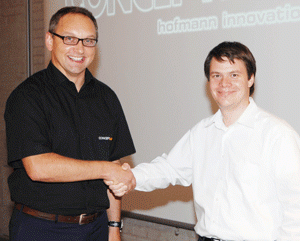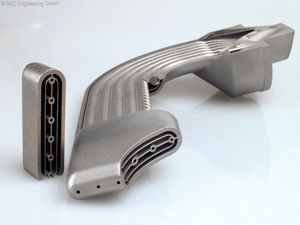Partnership between Concept Laser and RSC Engineering announced
December 10, 2014
Concept Laser and RSC Engineering GmbH have announced a strategic partnership for engineering laser-fused components. RSC Engineering, based in Cologne, Germany, is a design consultancy with expertise of incorporating the benefits of metal Additive Manufacturing into the component development process.
Concept Laser’s LaserCUSING process is ideally suited for bionic or lightweight construction approaches that produce components with optimised geometries and offer new possibilities in areas such as functionality or resilience. RSC Engineering’s design activities are primarily in the areas of rapid prototyping, rapid tooling and rapid manufacturing.
Frank Herzog, President & CEO of Concept Laser, stated, “We are pleased to partner with RSC Engineering and Tim Richter [CEO of RSC Engineering]. Our users will benefit from our partnership with a design firm that can create process-oriented component designs using LaserCUSING for complex components. RSC Engineering’s list of references and expertise will give us a strong foundation for maximizing the potential of LaserCUSING.”
Process-oriented design is stated as a change from the traditional approach of substituting a milled or cast component and allows the advantages of Additive Manufacturing to be maximised. There are many reasons for this, states Richter, “Additional functions are now possible, such as cooling, production of moving parts in a one-shot process without assemblies, or lightweight structures that can withstand heavy stresses. Hybrid manufacturing solutions (combination of conventional processes and LaserCUSING) can bring together the best of both worlds. It’s all about understanding new possibilities and using them in a targeted way. Additive design eliminates the need for substitution and produces completely new solutions.”
“Lightweight constructions are often used for component structures that cannot be adequately produced using traditional processes, whereas functional integration improves the quality of a component,” added Richter. “We focus on the component’s ultimate function right at the beginning of the design process. ‘Virtual prototyping’ is an important concept. Going from a virtual prototype to the actual product is no longer a big process thanks to LaserCUSING. This means that we can often shorten the development process significantly.”
Exhaust gas probe with intelligent functional integration
An exhaust gas probe developed by RSC Engineering is an example of intelligent additive design. The probe is used to determine the composition of engine exhaust gases in a test system. The exhaust gas is up to 2100°C and under high pressure. Due to these high temperatures the exhaust gas probe also features cooling channels for coolant flow in addition to six pipes for collecting the exhaust gas.
Conventional exhaust gas probes are typically welded, which is a time-consuming process. By contrast, the exhaust gas probe by RSC Engineering was manufactured in one step, including all flow-optimised channels, using LaserCUSING.
“Such highly effective functions can be very compactly integrated into an intelligently designed additive component,” stated Richter. “But the problem was in the costs. The product costing analysis for the exhaust gas probe showed that we reduced manufacturing costs by almost 60%. This demonstrates the incredible cost-cutting potential of this technology.”
Subscribe to our FREE e-newsletter
Useful links: News | Articles | Introduction to metal Additive Manufacturing



















